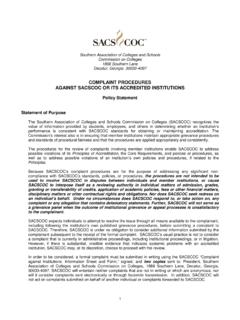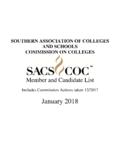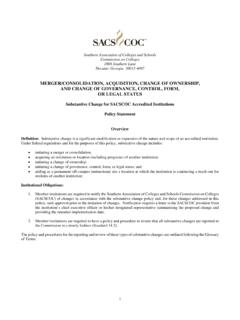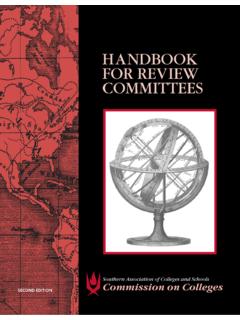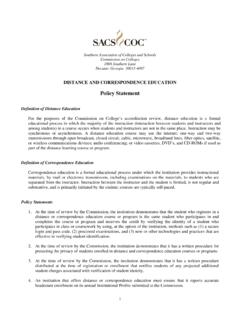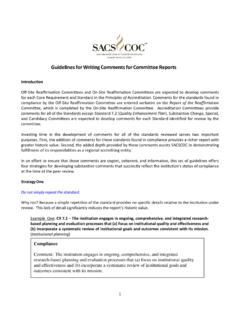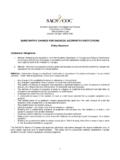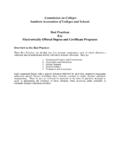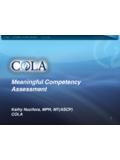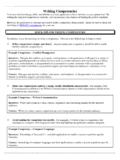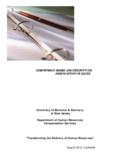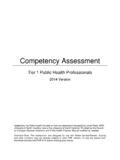Transcription of Policy Statement - sacscoc.org
1 1 Southern Association of Colleges and Schools Commission on Colleges 1866 Southern Lane Decatur, Georgia 30033-4097 DIRECT assessment competency - based EDUCATIONAL PROGRAMS Policy Statement Academic credit has provided the basis for measuring the amount of engaged learning time expected of a typical student enrolled not only in traditional classroom settings but also laboratories, studios, internships and other experiential learning, and distance and correspondence education. Students, institutions, employers, and others rely on the common currency of academic credit to support a wide range of activities, including the transfer of students from one institution to another. In recent years, some institutions have recognized the potential of innovative learning models and have developed creative programs that allow students the flexibility to learn at the pace that makes sense for them, both in career-technical and degree programs.
2 Students progress in these programs by demonstrating their achievement of specific skills or knowledge. These programs, commonly called competency - based programs, fit into traditional learning models that measure progress in credit or clock hours, but increasing numbers do not. Direct assessment competency - based educational programs use the direct assessment of student learning in lieu of measuring student learning in credit or clock hours. The purpose of this Policy is to provide guidance to institutions and evaluation committees on the Commission s expectations regarding the establishment and review of direct assessment competency - based programs and its hybrids as defined below. Definitions.
3 For the purpose of the application of this Policy and in accord with federal regulations, the Commission uses the following definitions: competency : A competency is a clearly defined and measurable Statement of the knowledge, skill, and ability a student has acquired in a designated program. competency - based Educational Programs. A competency - based educational program is outcome- based and assesses a student s attainment of competencies as the sole means of determining whether the student earns a degree or a credential. Such programs may be organized around traditional course- based units (credit or clock hours) that students must earn to complete their educational program, or may depart from course- based units (credit or clock hours) to rely solely on the attainment of defined competencies.
4 Direct assessment competency - based Educational Programs (also referred to in this Policy as direct assessment programs). Federal regulations define a direct assessment competency - based educational program as an instructional program that, in lieu of credit hours or clock hours as a measure of student learning, uses direct assessment of student learning relying solely on the attainment of defined competencies, or recognizes the direct assessment of student learning by others. The assessment must be consistent with the accreditation of the institution or program using the results of the assessment . 2 Hybrid Direct assessment competency - based Educational Programs (also referred to in this Policy as hybrid programs). A hybrid competency - based educational program combines course- based competencies (clock and credit hours awarded) with non-course based competencies (no clock or credit hours awarded).
5 Characteristics of a Direct assessment competency - based Educational Program. A direct assessment program has several characteristics: 1. It does not subscribe to conventional notions of the clock hour, seat time, term length, or the credit hour; rather, it relies on the student s ability to demonstrate clearly defined and measurable competencies in a designated program. 2. It is designed and delivered within the framework of the program s defined knowledge, skills, and competencies as demonstrated by students, rather than in terms of prescribed courses. 3. A student may acquire the requisite competencies from multiple sources and at various times other than, or in addition to, the learning experiences provided by the institution.
6 As such, the length of time it takes to demonstrate learning may be different for each student. 4. It often allows for alternative approaches to teaching and learning. 5. If may rely almost exclusively upon students using direct assessment testing models to demonstrate their mastery of program and degree content. Direct assessment as a Substantive Change. Because the initiation of a direct assessment or a hybrid program constitutes the addition of courses or programs that represent a significant departure, either in content or method of delivery, from those offered when the institution was last evaluated, each program is considered a substantive change that requires approval by SACSCOC Board of Trustees. Substantive change Policy statements related to direct assessment and hybrid programs, as well as to other types of substantive changes, can be found in Appendix A of this document.
7 Commission Obligations in the Review of Direct assessment competency - based Educational Programs. In accord with federal Policy as it relates to direct assessment competency - based programs only, SACSCOC is required to (1) evaluate the institution s offering of direct assessment programs and include them in the institution s grant of accreditation and (2) confirm the institution s claim of the direct assessment program s equivalence in terms of credit or clock hours and any other information that the DOE may require to determine whether to approve the institution s application. As with the identification of non-compliance with other standards of the Principles of Accreditation, the Commission is obligated to take action in accord with that used in relation to other standards of non-compliance.
8 Because SACSCOC requires approval of direct assessment and hybrid programs, once approved, the offering of both types of competency - based programs will be included in the institution s award of accreditation. Institutional Obligations. The Commission s requirements, policies, processes, and procedures are predicated on the expectation that an institution operates with integrity in all matters, including the maintenance of academic quality in the establishment of direct assessment competency - based educational programs. An institution is responsible for the academic quality of any credit or clock hour unit or any competency - based unit recorded on the institution s transcript, whether applied to a direct assessment or a hybrid program.
9 In determining whether to approve a direct assessment or hybrid program, the Commission expects that the institution will comply with the following practices and procedures: (1) adhere to initial obligations and an expected framework; (2) ensure compliance with appropriate SACSCOC requirements and standards outlined in the Principles for Accreditation and with Commission Policy ; and (3) follow procedures for the notification and approval of the substantive change. 1. Adherence to Initial Obligations and an Expected Framework Report the initiation of direct assessment and hybrid programs. The institution has an obligation to notify the Commission and seek approval for the offering of such programs.
10 Once approved, the direct assessment and hybrid programs will be included in the institution s award of accreditation. To secure 3 federal financial aid, the institution must also seek approval from the Department of Education only if the entire program is a direct assessment competency - based program. Identify institutional contributions. The institution offering the direct assessment is able to identify and articulate the educational contribution it provides to students in this program. Such contribution may take the form of modules, engagement with faculty, exercises, assessment of student learning or other activities that either expand the student s knowledge beyond any prior learning that the student may have demonstrated upon entry into the direct assessment or hybrid competency - based program or that assist the student in documenting how prior learning translates to the attainment of competencies required for receiving academic credit.

